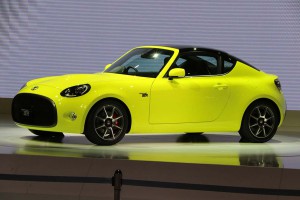No surprise, considering the size of the brand, Toyota’s stand at the Tokyo Motor Show is filled with a variety of new concept and production models – as well as a pint-sized robot. They cover a vast range of automotive genres, from fuel-cell vehicles to a pair of sports car options.
The Kikai is a minimalist design that lets you get a clear look at the machinery that drives the beast. The little S-FR is a bit more traditional – and more likely to land in showrooms in the near future as the anchor of Toyota’s new three sports car strategy.
With its widemouth bass of a grille, the S-FR adopts classic sports car proportions, with a long hood, a low roof and a compact powertrain driving the rear wheels. But it measures a mere 13 feet, nose-to-tail and is small enough to look well-proportioned riding on tiny 15-inch wheels.
“The concept’s long nose and wide stance make for an archetypal sports car profile, while the familiar roundness of its frame inspires a feeling of closeness,” the maker explains, adding that, “The simple and modern finish of the interior rounds off a design that stresses approachable simplicity while conveying the vehicle’s performance and sporty spirit.”

The S-FR concept would likely be powered by a naturally aspirated, 1.5-liter inline-four making about 130 horsepower.
Unfortunately, Toyota leaves us guessing when it comes to such details as powertrain options, but there are strong rumors floating around the Tokyo Motor Show that it would use a naturally aspirated, 1.5-liter inline-four making about 130-horsepower. That would be reasonably peppy in a Mazda Miata sort of way, considering the likely weight of the little sports car – about 2,150 pounds.
The distinctive exterior of the S-FR fits into Toyota’s growing emphasis on “passionate” design. And that carries over into the cabin, where the instrument panel has but a single digital display. Apparently, Toyota expects a lot of other information will be shared through a smartphone, a special mount placed smack in the middle of the dashboard.
Surprisingly, the Toyota is a 2+2 design, though that layout looks impractical, even in Japan where microcars are becoming more the norm every day.
(Toyota bringing three concept cars to Tokyo Motor Show: and a robot. For more, Click Here.)
Short for Small, Front-engine, Rear-drive, the Toyota S-FR will appear on the Tokyo stage in concept form but is soon expected to anchor the trio of performance models, just below the model Americans know as the Scion FR-S. At the top end, Toyota will soon reveal the fruits of an ongoing joint venture with BMW that is expected to revive the long-absent Supra nameplate.

Toyota's Kikai concept comes across as a three-way blend of hot rod, dune buggy and those unique-to-Japan Kei-class minicars.
That high-line sports car definitely will be U.S. bound. As for the Toyota S-FR, it’s all but certain to reach the Japanese market and perhaps a few others, but whether the Japanese giant would risk trying to slot in something even smaller than the Scion FR-S into the States is far less certain.
Meanwhile, don’t expect to see the Toyota Kikai in showrooms, but it’s a compelling design exercise, nonetheless.
(To see more about Toyota’s recall of 6.5 million vehicles, Click Here.)
This concept takes the machinery, normally hidden beneath the vehicle body, and makes an open display of its beauty,” the maker says in a release. “Directly expressed in this way, the vehicle’s inner workings become part of the exterior.”
Think of the Toyota Kikai as sort of the automotive equivalent of the popular “bodies” exhibits that have been touring the U.S. showing us the inner workings of the human body. In this case, however, the unadorned machinery is meant to run.
(Click Here for details about how Toyota recaptured the top global auto sales spot.)
Visually, Kikai comes across as a three-way blend of hot rod, dune buggy and those unique-to-Japan Kei-class minicars. The driver sits alone up front, more or less centered behind a set of classic, analog gauges. There are two additional seats behind.

